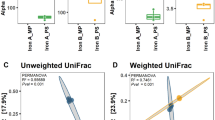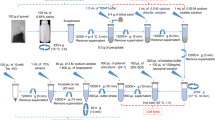Abstract
DNA extraction is often considered as the limiting step of most molecular approaches in ecology and environmental microbiology. Ten existing DNA extraction protocols were compared for recovery of DNA from sludge and a modified version of the protocol described by Porteous et al. (Mol Ecol 6:787–791, 1997) was determined to be the best method for recovery of DNA suitable for PCR. In this respect, it appeared that the commonly used guanidine isothiocyanate could impair the quality of the extracted DNA unless its concentration is lowered. Second, conditioning the samples as liquors as opposed to pellets critically impacts the outcome of the extraction. The suitability of the modified Porteous protocol for quantitative PCR applications is demonstrated in a series of experiments showing the absence of interfering coextracted inhibitors and the linear correspondence between the concentrations of input target DNA and PCR product. Interestingly, it is also shown that the nature of the environmental matrices affects the recovery yield of both circular plasmids and chromosomal DNA, resulting in an apparent fluctuation of the plasmid copy number per cell. This means that quantitative data obtained by PCR remain comparable as long as they apply to an identical target sequence extracted from a similar environment and amplified under the same conditions.



Similar content being viewed by others
References
Adamczyk M, Jagura-Burdzy G (2003) Spread and survival of promiscuous IncP-1 plasmids. Acta Biochim Pol 50:425–453
Adamczyk M, Dolowy P, Jonczyk M, Thomas CM, Jagura-Burdzy G (2006) The kfrA gene is the first in a tricistronic operon required for survival of IncP-1 plasmid R751. Microbiology 152:1621–1637
Bonot S, Merlin C (2010) Monitoring the dissemination of the broad host range plasmid pB10 in sediment microcosms by quantitative PCR. Appl Environ Microbiol 76:378–382
Bourrain M, Achouak W, Urbain V, Heulin T (1999) DNA extraction from activated sludges. Curr Microbiol 38:315–319
Dong D, Yan A, Liu H, Zhang X, Xu Y (2006) Removal of humic substances from soil DNA using aluminium sulfate. J Microbiol Meth 66:217–222
Guillaume G, Verbrugge D, Chasseur-Libotte ML, Moens W, Collard JM (2000) PCR typing of tetracycline resistance determinants (Tet A-E) in Salmonella enterica serotype Hadar and in the microbial community of activated sludges from hospital and urban wastewater treatment facilities in Belgium. FEMS Microbiol Ecol 32:77–85
Lane DJ (1991) 16S/23S rRNA sequencing. In: Stackebrant E, Goodfellow M (eds) Nucleic acid techniques in bacterial systematics. John Wiley and Sons, Chichester, UK, pp 115–175
Lemarchand K, Berthiaume F, Maynard C, Harel J, Payment P, Bayardelle P, Masson L, Brousseau R (2005) Optimization of microbial DNA extraction and purification from raw wastewater samples for downstream pathogen detection by microarrays. J Microbiol Meth 63:115–126
Martin-Laurent F, Philippot L, Hallet S, Chaussod R, Germon JC, Soulas G, Catroux G (2001) DNA extraction from soils: old bias for new microbial diversity analysis methods. Appl Environ Microbiol 67:2354–2359
Porteous LA, Seidler RJ, Watrud LS (1997) An improved method for purifying DNA from soil for polymerase chain reaction amplification and molecular ecology applications. Molec Ecol 6:787–791
Purohit HJ, Kapley A, Moharikar AA, Narde G (2003) A novel approach for extraction of PCR-compatible DNA from activated sludge samples collected from different biological effluent treatment plants. J Microbiol Meth 52:315–323
Rådström P, Knutsson R, Wolffs P, Lövenklev M, Löfström C (2004) Pre-PCR processing: strategies to generate PCR-compatible samples. Mol Biotechnol 26:133–146
Schlüter A, Heuer H, Szczepanowski R, Forney LJ, Thomas M, Pühler A, Top EM (2003) The 64 508 bp IncP-1β antibiotic multiresistance plasmid pB10 isolated from a waste-water treatment plant provides evidence for recombination between members of different branches of the IncP-1β group. Microbiology 149:3139–3153
Smith CJ, Osborn AM (2009) Advantages and limitations of quantitative PCR (Q-PCR)-based approaches in microbial ecology. FEMS Microbiol Ecol 67:6–20
Stults JR, Snoeyenbos-West O, Methe B, Lovley DR, Chandler DP (2001) Application of the 5′ fluorogenic exonuclease assay (TaqMan) for quantitative ribosomal DNA and rRNA analysis in sediments. Appl Environ Microbiol 67:2781–2789
Wilson IG (1997) Inhibition and facilitation of nucleic acid amplification. Appl Environ Microbiol 63:3741–3751
Yu Z, Mohn WW (1999) Killing two birds with one stone: simultaneous extraction of DNA and RNA from activated sludge biomass. Can J Microbiol 45:269–272
Acknowledgments
This work was initiated thanks to the collaboration and financial support of SUEZ-Environment (funded by R + i Alliance). Additional support was gained from the EC2CO national program and Zone Atelier Moselle (ZAM). S. Bonot was recipient of a CIFRE fellowship from the ANRT and SUEZ-Environment. Part of this work was presented by S. Bonot at the 2008 WEFTEC® annual conference. We thank B. Lartiges from LEM for kindly providing a Moselle sediment analysis.
Author information
Authors and Affiliations
Corresponding author
Rights and permissions
About this article
Cite this article
Bonot, S., Courtois, S., Block, JC. et al. Improving the recovery of qPCR-grade DNA from sludge and sediment. Appl Microbiol Biotechnol 87, 2303–2311 (2010). https://doi.org/10.1007/s00253-010-2686-0
Received:
Revised:
Accepted:
Published:
Issue Date:
DOI: https://doi.org/10.1007/s00253-010-2686-0




